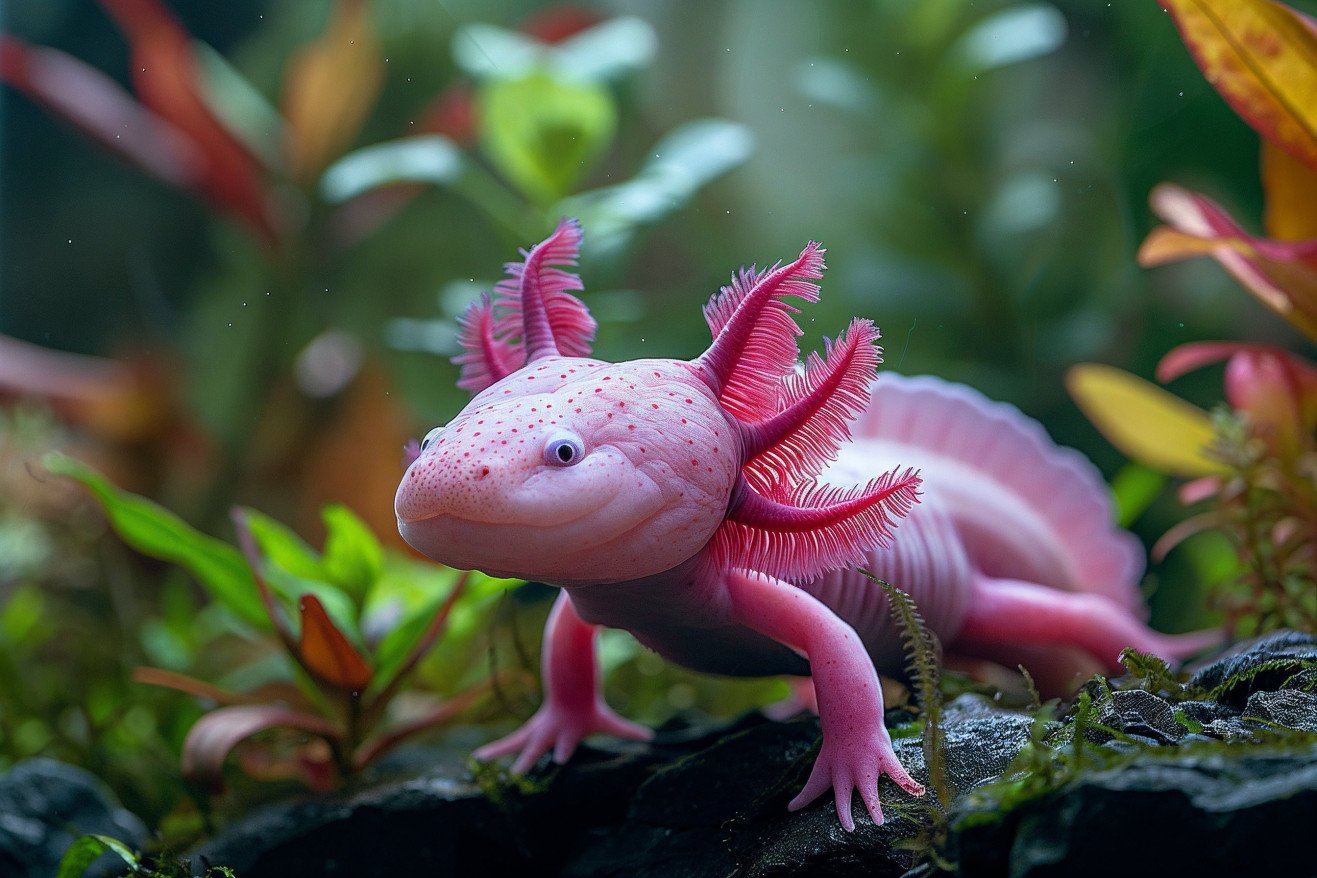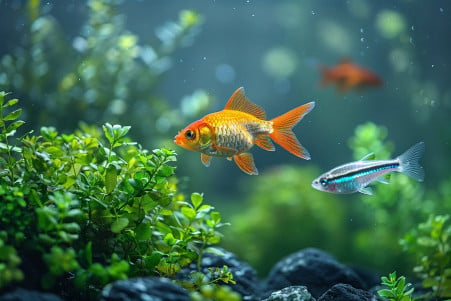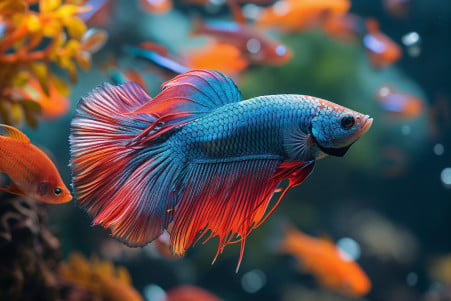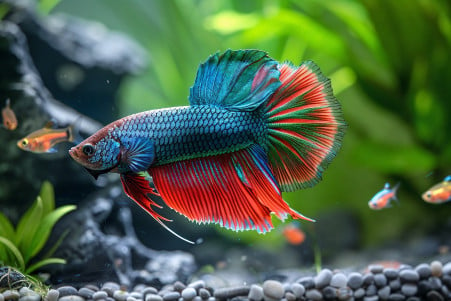Can Axolotls Live With Fish? Insights on Aquarium Cohabitation
6 February 2024 • Updated 6 February 2024

One of the most common questions among aquarium hobbyists is whether or not axolotls can live with other fish. While there are many species that can live with axolotls, some of the best options include White Cloud Mountain Minnows, Guppy Fish, and Zebra Danios.
All of these fish are peaceful and large enough to avoid being eaten by axolotls. However, it’s important to avoid aggressive or nippy fish and to make sure that the tank is set up to meet the needs of both species.
This investigation will draw on research from herpetology, marine biology, and aquarium care to provide a comprehensive look at the topic of keeping axolotls with fish. By looking at behavioral research, environmental requirements, and dietary needs, this investigation will give you a complete picture of how compatible these species can be.
Ultimately, this investigation will give you the information you need to set up a successful tank that supports the health and well-being of both axolotls and the other animals you choose to keep with them.
Can Axolotls live with fish?
Best Tank Mates for Your Axolotl
In order to maintain a harmonious living situation for your axolotls, it is important to choose tank mates that are neither prey nor predators. According to AquariumStoreDepot, some of the best tank mates for axolotls are White Cloud Mountain Minnows, Guppy Fish, and Zebra Danios.
These species are large enough to discourage axolotls from eating them and fast enough to get away if they need to. Apple Snails are also recommended because they are peaceful and too big to be eaten by axolotls.
On the other hand, there are several species that are not recommended as tank mates for axolotls. PetHelpful warns against keeping axolotls with Goldfish, Cory Catfish, Otocinclus Catfish, and most Freshwater Shrimp.
Goldfish are known to nip fins and pester axolotls, while Cory Catfish and Otocinclus Catfish can cause injuries with their spines. In addition, some tropical fish, turtles, and plecos have specific environmental or behavioral needs that are not compatible with axolotls and can cause harm.
Territorial or aggressive fish can cause injuries to axolotls and upset the delicate balance that is required for all species in the tank to be happy and healthy. The ultimate goal is to make sure that all of the aquatic animals in the tank are able to live together without fear or competition.
Choosing the right tank mates is important for the overall well-being of the animals in the tank, and this is directly tied to their dietary compatibility.
Meeting the Dietary Requirements of Axolotls and Fish
Axolotls are obligate carnivores and need a diet that consists of a variety of live or frozen meaty foods like worms and brine shrimp. FishLab notes that axolotls are nocturnal feeders in the wild, which means they hunt at night.
This means that in captivity, their diet should be well-rounded and include a variety of small aquatic animals. This is in contrast to many common freshwater fish, which may eat algae or flake foods. Instead, axolotls need a diet that includes animal protein to ensure they grow and stay healthy.
This is where potential problems can arise when it comes to choosing tank mates. If an axolotl is hungry, it may eat smaller fish or invertebrates in the tank.
A study by Dean J. Slight on ScienceDirect found that while offering a mixed diet to axolotls didn’t hurt their growth or behavior, it didn’t improve it over a high-quality single-prey-species diet. This means that it’s important to make sure that the food you’re feeding your axolotl is high-quality and nutrient-dense, but not so much so that it encourages predatory behavior toward other tank mates.
To make sure that all tank mates can live together peacefully, it’s important to make sure that each species’ dietary needs are met. This means that axolotls should be fed a diet that meets their specific needs, which Axolotl.org notes should include high-quality foods that are low in fat and nutritionally balanced to avoid health problems.
By making sure that both axolotls and fish are fed diets that meet their specific needs, and that they’re fed enough to meet those needs, you can help prevent aggression due to competition and create a peaceful tank environment for all of your aquarium’s inhabitants.
Water Quality and Compatibility of Axolotls and Fish
Water Critters explains that axolotls need certain water conditions to thrive, such as a temperature between 15–21°C, a pH of 7.4 to 7.6, and a general hardness (GH) of 7–14. Many of the most common freshwater fish that can live with axolotls have similar water needs, which makes it easier to set up a tank that works for both axolotls and fish.
Water quality is one of the most important factors in the health of any aquatic animal. It impacts their biological functions and overall health, and it needs to be monitored and maintained. Even small changes in water quality can be stressful or harmful to your pets. Water Critters recommends that a good filter system will help maintain these water parameters, and that you should also do weekly water changes of 25 to 50%.
VIN explains that if you keep up with regular maintenance and water testing to make sure that your water quality is where it needs to be, you can avoid issues like increased mucus production, inappetance, and even death that can come from water quality issues.
If you know what your pets need and you’re able to provide it, you can make sure that their environment is healthy and stable and that they can live long, healthy lives together.
Social Behavior in Axolotl–Fish Tanks
Although axolotls are solitary and asocial, and therefore don’t have complex social structures, their social behavior still needs to be considered in a tank. While axolotls aren’t highly territorial, According to Caudata.org, axolotls may engage in cannibalism when confined in small spaces, which makes it important to create roomy tanks and thoughtfully designed habitats that prevent aggressive interactions.
Meanwhile, typical freshwater fish have a wide variety of social behaviors, from the social nature of Guppy Fish to the territorial behavior of some cichlids. To help ensure that both axolotls and fish can live together peacefully, tanks should be set up with hiding spaces and enough room for both species to establish their own territories, which will help reduce stress and prevent aggression.
In addition, The International Environment Library Consortium notes that the axolotl is a top predator in its natural environment, which suggests that it may be predatory toward smaller tank mates. By observing interactions and making any necessary changes to the tank environment, fish and axolotls can coexist peacefully. However, this will only be possible if the social behavior of each species is understood and accommodated.
How to Keep Water Flow and Filtration in Balance for Healthy Axolotl and Fish Tanks
It’s important to know how to balance water flow and filtration in order to keep both axolotls and their fish tank mates healthy. Axolotls need calm or slow-moving water because strong water currents can stress them out and even make them sick. Axolotl.org even lists excessive water flow as a stressor for axolotls.
However, many fish that can live with axolotls have similar filtration needs, which means that the two can coexist in the same tank.
As Tropical Fish Hobbyist Magazine points out, aquarium filtration systems, which can include mechanical, chemical, and biological filtration, can be customized to fit different kinds of tanks.
For tanks that house multiple species, sponge filters can provide the low water flow that axolotls need while also offering the biological filtration that all tanks need to stay healthy. Meanwhile, more powerful filters like canister filters can be turned down to a lower flow rate that works for both axolotls and fish, ensuring that the tank stays clean and clear without stressing out the animals.
Arizona Exotics stresses the importance of keeping the filtration system in good working order. Regular maintenance, including cleaning and replacing filter media, will help ensure that the tank doesn’t become toxic with ammonia and other harmful substances, which will help keep the tank stress-free and peaceful. With the right care and attention to filtration, the animals in a tank can live in a healthy, balanced environment.
Building a Balanced Ecosystem: Axolotls and Fish Living Together
In the sprawling landscape of the home aquarium, axolotls can live with fish if certain requirements are met. It’s important to choose the right tank mates, like White Cloud Mountain Minnows and Guppy Fish, that won’t pose a threat to axolotls.
It’s also important to make sure that all animals in the tank are being fed a well-rounded diet, as this will help to ensure that no one is competing for food and that everyone is getting the nutrients they need.
Maintaining the right water conditions is also important for keeping the peace. It’s important to make sure that the water is clean and that it meets the needs of both axolotls and fish.
In addition, it’s important to understand the social needs and territorial behaviors of axolotls and the other animals that will be living in the tank with them. Finally, it’s important to make sure that the tank’s filtration and water movement systems are set up in a way that will meet the needs of both axolotls and fish.
As caretakers of these unique animals, it’s important to make sure that you’re constantly researching, observing, and adjusting the environment to make sure that it’s as stress-free as possible. It’s also important to make sure that you’re always learning and showing empathy to these animals. It’s through this dedication that a balanced and thriving environment for axolotls and fish can be achieved.


